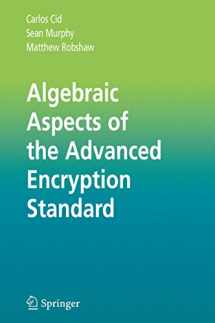
Algebraic Aspects of the Advanced Encryption Standard
ISBN-13:
9781441937292
ISBN-10:
1441937293
Edition:
Softcover reprint of hardcover 1st ed. 2006
Author:
Sean Murphy, Carlos Cid, Matthew Robshaw
Publication date:
2010
Publisher:
Springer
Format:
Paperback
156 pages
FREE US shipping
Book details
ISBN-13:
9781441937292
ISBN-10:
1441937293
Edition:
Softcover reprint of hardcover 1st ed. 2006
Author:
Sean Murphy, Carlos Cid, Matthew Robshaw
Publication date:
2010
Publisher:
Springer
Format:
Paperback
156 pages
Summary
Algebraic Aspects of the Advanced Encryption Standard (ISBN-13: 9781441937292 and ISBN-10: 1441937293), written by authors
Sean Murphy, Carlos Cid, Matthew Robshaw, was published by Springer in 2010.
With an overall rating of 3.6 stars, it's a notable title among other
Information Theory
(Computer Science, Data Processing, Databases & Big Data, Security & Encryption) books. You can easily purchase or rent Algebraic Aspects of the Advanced Encryption Standard (Paperback) from BooksRun,
along with many other new and used
Information Theory
books
and textbooks.
And, if you're looking to sell your copy, our current buyback offer is $0.3.
Description
The Belgian block cipher Rijndael was chosen in 2000 by the U.S. government's National Institute of Standards and Technology (NIST) to be the successor to the Data Encryption Standard. Rijndael was subsequently standardized as the Advanced Encryption Standard (AES), which is potentially the world's most important block cipher. In 2002, some new analytical techniques were suggested that may have a dramatic effect on the security of the AES. Existing analytical techniques for block ciphers depend heavily on a statistical approach, whereas these new techniques are algebraic in nature. Algebraic Aspects of the Advanced Encryption Standard, appearing five years after publication of the AES, presents the state of the art for the use of such algebraic techniques in analyzing the AES. The primary audience for this work includes academic and industry researchers in cryptology; the book is also suitable for advanced-level students.


We would LOVE it if you could help us and other readers by reviewing the book
Book review

Congratulations! We have received your book review.
{user}
{createdAt}
by {truncated_author}


